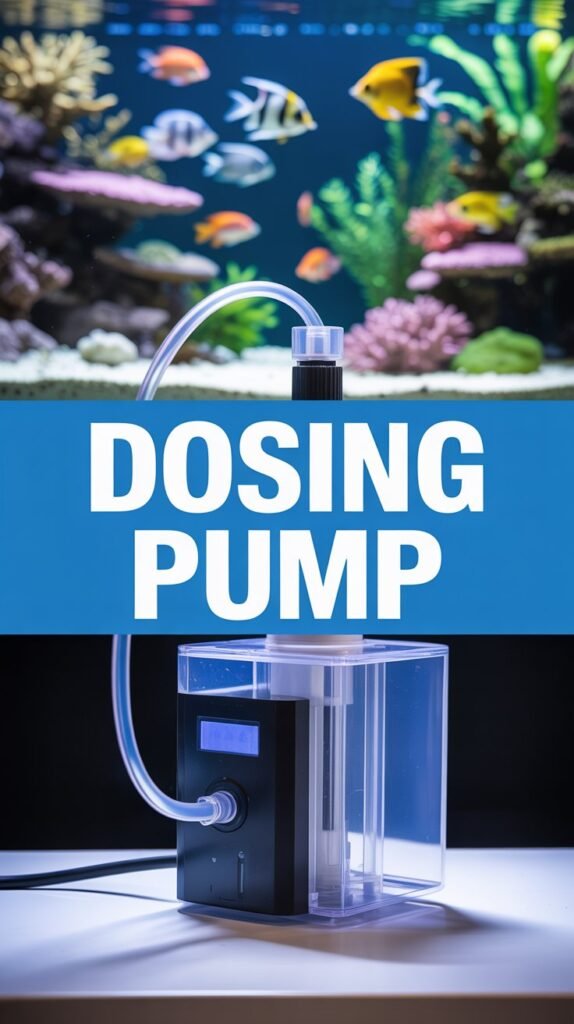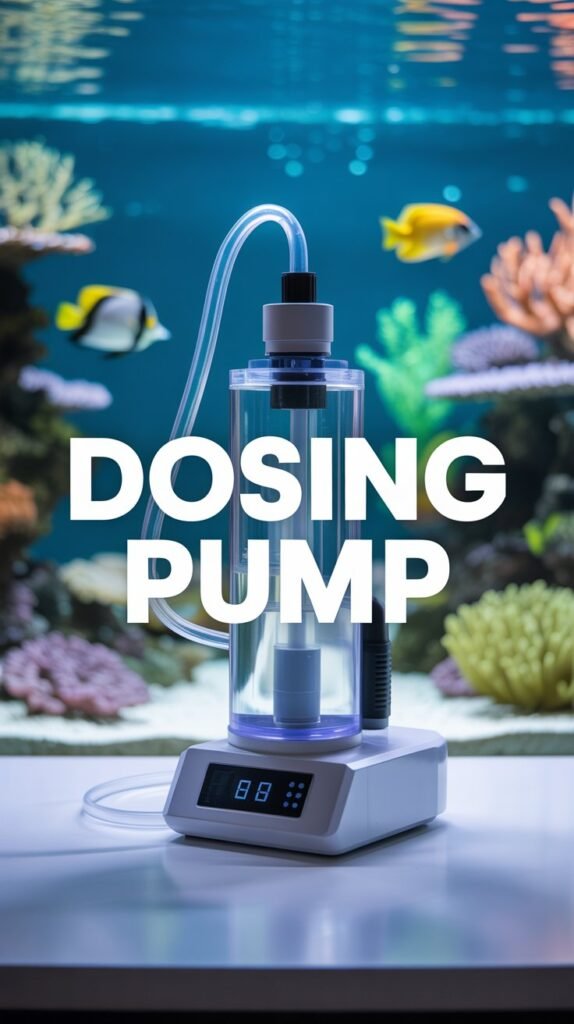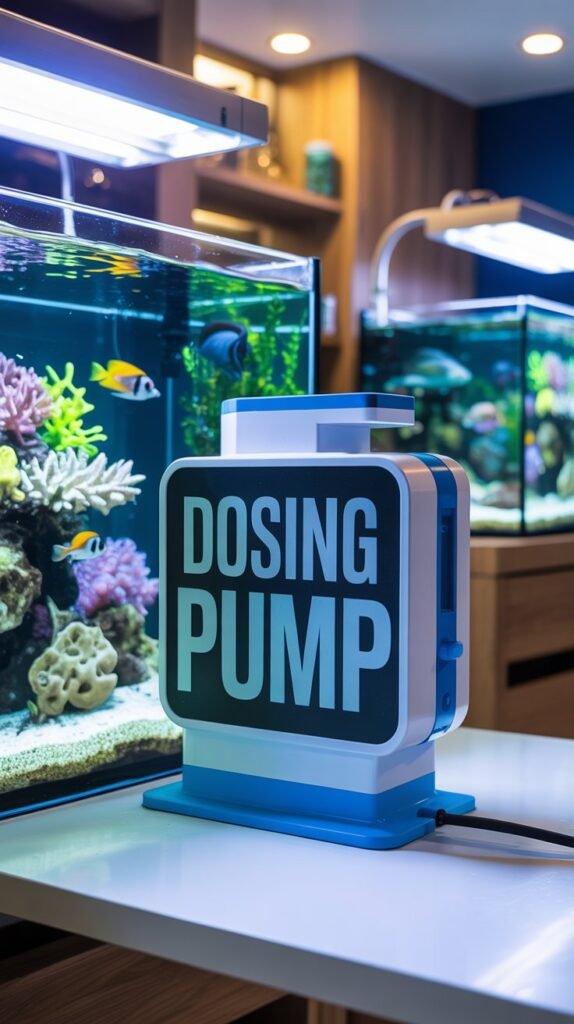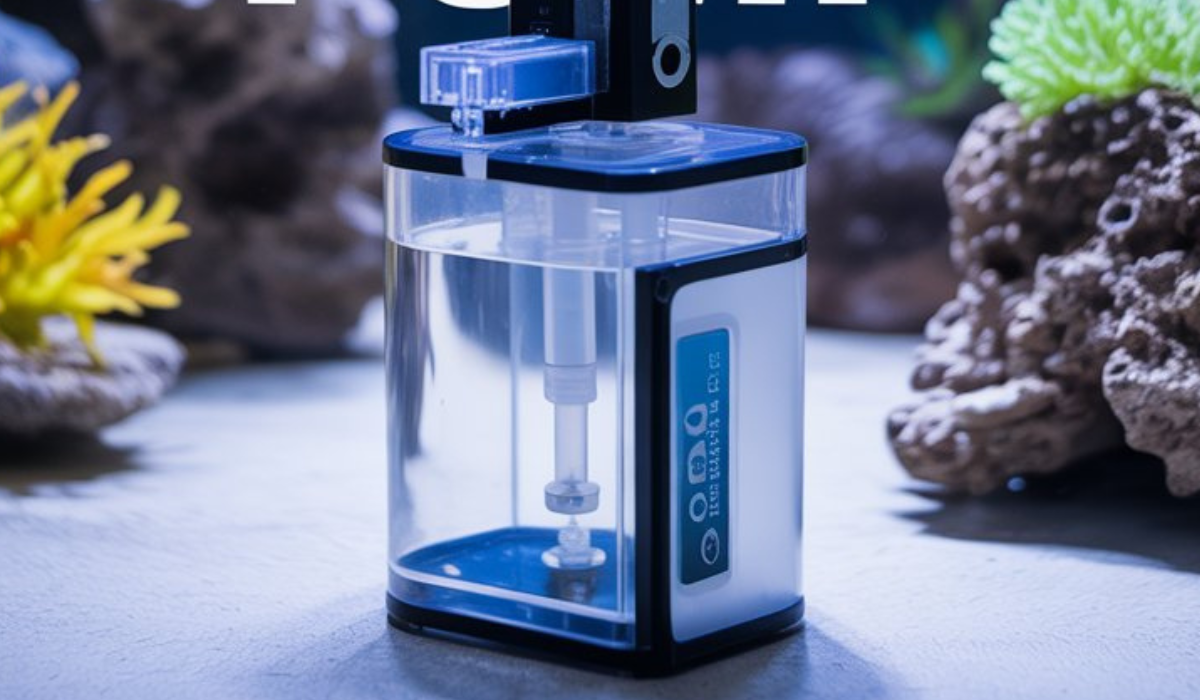Maintaining a healthy and balanced aquarium requires precision — especially when it comes to adding fertilizers, supplements, and essential nutrients. Whether you have a reef tank, planted aquarium, or freshwater setup, a dosing pump can make your aquarium maintenance far easier and more consistent.
In this comprehensive guide, we’ll explore everything you need to know about dosing pumps — how they work, their benefits, setup tips, and how to choose the right model for your aquarium.
What Is a Dosing Pump?
A dosing pump is an automatic device designed to accurately deliver small, controlled amounts of liquid substances into your aquarium over time. These substances can include:
- Fertilizers for planted aquariums
- Calcium, alkalinity, and magnesium for reef tanks
- Trace elements like iron and potassium
- Medications or dechlorinators
Dosing pumps are especially useful in aquariums that require consistent supplementation, ensuring your fish, corals, and plants receive the nutrients they need without fluctuations.
How Does a Dosing Pump Work?

Dosing pumps operate using peristaltic technology. Inside the pump, a small motor rotates rollers that squeeze flexible tubing. As the rollers move, they push liquid through the tube and out into the aquarium.
This design allows for:
- Accurate and repeatable dosing
- No backflow or leakage
- Easy calibration and maintenance
Modern dosing pumps can be manually controlled, programmable, or Wi-Fi-enabled, giving you full automation and remote access.
Why Use a Dosing Pump in an Aquarium?
Consistency is key to aquarium success. Manually adding supplements may seem simple, but small daily variations can lead to nutrient imbalances, algae blooms, or coral stress. A dosing pump eliminates guesswork and ensures steady water chemistry.
Here are some major benefits:
1. Precision and Accuracy
Dosing pumps deliver exact quantities down to the milliliter. This consistency helps maintain stable parameters and prevents overdose or deficiency.
2. Automation
You can schedule doses at specific intervals — daily, hourly, or even multiple times a day. This automation saves time and effort.
3. Stability in Water Chemistry
Stable levels of nutrients, fertilizers, or minerals support healthy plant and coral growth, preventing sudden fluctuations that could harm your aquarium inhabitants.
4. Reduced Human Error
No more forgetting to add fertilizers or overdosing nutrients — the dosing pump ensures accuracy every time.
5. Improved Growth and Color
In reef tanks, corals thrive under stable calcium, alkalinity, and magnesium conditions. In planted tanks, consistent dosing leads to lush, vibrant growth.
Types of Dosing Pumps

There are several types of dosing pumps used in aquariums, depending on automation level, number of channels, and functionality.
1. Single-Head Dosing Pump
A single-head pump dispenses one type of liquid at a time. It’s ideal for small tanks or aquarists who only dose one supplement, such as fertilizer or calcium.
Pros:
- Affordable and easy to use
- Suitable for beginners
- Compact design
Cons:
- Limited to one liquid; multiple units are needed for multi-dosing
2. Multi-Head Dosing Pump
Multi-head (or multi-channel) dosing pumps feature 2–8 channels, allowing you to dose several liquids simultaneously — perfect for advanced planted tanks and reef systems.
Pros:
- Doses multiple substances automatically
- Programmable schedules for each channel
- Compact and efficient
Cons:
- More expensive
- Slightly more complex setup
3. Programmable Digital Dosing Pump
These pumps come with built-in LCD screens and programming menus. You can control the amount, frequency, and timing of each dose precisely.
Pros:
- High accuracy
- User-friendly interface
- Saves dosing schedules
Cons:
- Mid-to-high price range
4. Wi-Fi or Smart Dosing Pump
The most advanced option, smart dosing pumps allow remote control via mobile apps. You can adjust dosing schedules, monitor status, and receive alerts directly on your phone.
Pros:
- Total remote control
- Integration with smart aquarium systems (like Apex or GHL)
- Real-time data monitoring
Cons:
- Higher cost
- Requires Wi-Fi connectivity
Applications of Dosing Pumps in Aquariums
Dosing pumps can be used across different aquarium types for specific goals.
1. Reef Aquariums
Reef tanks have a high demand for minerals due to coral growth. Dosing pumps ensure stable parameters for:
- Calcium (Ca)
- Alkalinity (KH or dKH)
- Magnesium (Mg)
- Trace elements (Iodine, Strontium, Iron)
Stable dosing prevents coral bleaching, improves skeletal growth, and enhances coloration.
2. Planted Aquariums
In freshwater planted tanks, plants require consistent nutrients for photosynthesis and growth. Dosing pumps can add:
- Macronutrients: Nitrogen (N), Phosphorus (P), Potassium (K)
- Micronutrients: Iron (Fe), Manganese (Mn), Zinc (Zn), Copper (Cu)
- Liquid CO₂ supplements
Automated dosing promotes lush plant growth and prevents algae caused by inconsistent fertilization.
3. Freshwater Fish Tanks
While not essential for simple fish-only tanks, dosing pumps can still help:
- Administer water conditioners or dechlorinators
- Dose medications or beneficial bacteria
- Add minerals for soft water fish species
How to Set Up a Dosing Pump

Setting up a dosing pump might seem technical, but it’s straightforward when done step-by-step.
Step 1: Gather Materials
- Dosing pump (single or multi-head)
- Dosing containers or bottles
- Tubing (usually silicone)
- Check valves (to prevent backflow)
- Measuring cup or graduated cylinder
Step 2: Mount the Pump
Secure the dosing pump above or beside your aquarium or sump. Avoid placing it below the liquid containers to prevent siphoning.
Step 3: Connect the Tubing
Attach one end of the tube to the dosing liquid container and the other to the aquarium or sump. Label each tube to prevent mix-ups.
Step 4: Calibrate the Pump
Calibrate by running the pump for a set time (e.g., 1 minute) and measuring how much liquid it dispenses. Adjust accordingly to achieve precise dosing.
Step 5: Program the Schedule
Input dosing times, volume per dose, and intervals (daily, hourly, etc.). Spread doses evenly to maintain consistent water chemistry.
Step 6: Test and Observe
Monitor your aquarium parameters after installation. Adjust dosing volumes if necessary.
Choosing the Right Dosing Pump
Here are key factors to consider before purchasing a dosing pump:
1. Number of Channels
Decide how many liquids you plan to dose. For reef tanks, a 3–4 channel pump is ideal (Ca, KH, Mg, trace elements). For planted tanks, a 2–3 channel system works well (macros, micros, CO₂).
2. Accuracy and Calibration
Choose a pump with a high precision rate (±1–2%) and easy calibration options.
3. Programming Features
Ensure it supports daily, weekly, and custom scheduling for flexibility.
4. Build Quality
Look for sturdy materials, reliable motors, and silicone tubing designed for chemical resistance.
5. Brand and Support
Reputable brands like Jebao, Kamoer, Aqua Medic, Bubble Magus, and GHL offer durable and accurate pumps with available spare parts.
6. Budget
Basic models start around $40–$70, while advanced Wi-Fi-enabled pumps can exceed $200–$500.
Top-Rated Dosing Pumps for Aquariums (2025)
Here are some popular dosing pumps that aquarists trust:
| Brand/Model | Channels | Control Type | Best For |
|---|---|---|---|
| Jebao DP-4 | 4 | Digital | Reef/Planted tanks |
| Kamoer X1 Pro | 1 | Wi-Fi (App) | Nano and small tanks |
| Bubble Magus BM-T11 | 3 | Programmable | Large reef tanks |
| GHL Doser 2.2 | 4+ | Wi-Fi/Advanced | Professional setups |
| Aqua Medic SP 3000 | 1 | Manual | Simple applications |
Each model varies in precision, connectivity, and ease of use — but all are effective for stable dosing.
Maintenance and Care for Dosing Pumps
Dosing pumps are reliable but need occasional maintenance for long-term accuracy.
1. Clean Tubing Regularly
Replace or clean tubing every 3–6 months to prevent buildup and clogging.
2. Rinse Pump Heads
Run freshwater through the pump heads periodically to prevent crystallization from fertilizers or minerals.
3. Check Calibration
Recalibrate every few months or when changing liquids to maintain dosing accuracy.
4. Store Liquids Properly
Keep dosing solutions in sealed, labeled containers away from direct light and heat.
5. Inspect for Air Bubbles
Air in the line can disrupt dosing consistency. Prime the pump to remove trapped air.
Common Mistakes to Avoid
- Skipping Calibration – Leads to under- or overdosing.
- Mixing Liquids – Some additives react when mixed; always separate containers.
- Overdosing – Start small and increase gradually based on tank needs.
- Neglecting Maintenance – Build-up inside tubes reduces flow accuracy.
- Ignoring Parameter Testing – Always monitor pH, KH, Ca, and other parameters.
Avoiding these mistakes ensures your dosing pump works effectively for years.
Advantages of Using a Dosing Pump
- Consistent and accurate dosing
- Reduces manual work
- Prevents nutrient imbalances
- Customizable schedules
- Improves plant and coral health
- Compatible with automation systems
Whether you’re dosing fertilizers in a lush planted tank or maintaining calcium levels in a coral reef, a dosing pump brings convenience and precision.
DIY Dosing Pump System
For hobbyists who enjoy DIY projects, it’s possible to build a dosing system using:
- Low-cost peristaltic motors
- Arduino or Raspberry Pi controllers
- Aquarium tubing and connectors
A DIY setup can cost less but requires programming knowledge and careful calibration.
Troubleshooting Dosing Pump Issues
| Problem | Possible Cause | Solution |
|---|---|---|
| Pump not dispensing | Air bubbles or blockages | Prime tubing, clear obstructions |
| Inconsistent dosing | Calibration drift | Recalibrate the pump |
| Leaking tubing | Worn or loose fittings | Replace tubing and tighten connections |
| Liquid siphoning | Improper mounting | Install check valves and raise pump above liquid level |
Proper troubleshooting ensures reliable and continuous dosing performance.
The Role of Dosing Pumps in Aquarium Automation
With modern aquarium controllers (like Apex or GHL ProfiLux), dosing pumps can be integrated into a complete smart ecosystem. This allows real-time monitoring of water parameters and automatic adjustments — bringing aquarists one step closer to fully automated aquarium care.
You can program the system to:
- Pause dosing during feeding
- Adjust doses based on pH or nutrient readings
- Send alerts if a channel malfunctions
Such integrations make dosing pumps essential tools for serious aquarists and professionals.
Conclusion
A dosing pump is more than just an accessory — it’s an essential tool for maintaining aquarium stability, accuracy, and automation. Whether you’re growing vibrant aquatic plants or nurturing delicate corals, consistent dosing is the secret to long-term success.
By choosing the right model, calibrating carefully, and maintaining it properly, your dosing pump will ensure precise nutrient delivery and a balanced aquatic ecosystem.
Investing in a dosing pump is investing in the health, growth, and beauty of your aquarium — one drop at a time.
FAQs About Dosing Pumps
1. What does a dosing pump do in an aquarium?
A dosing pump automatically adds precise amounts of liquid supplements, fertilizers, or minerals to your tank at scheduled intervals.
2. Do I need a dosing pump for a freshwater aquarium?
If you have a planted tank that requires regular fertilization, yes. For basic fish-only setups, it’s optional.
3. How often should I use a dosing pump?
It depends on your aquarium’s needs. Most setups use daily or hourly dosing schedules for consistency.
4. Can I use one dosing pump for multiple liquids?
Only if it has multiple channels. Otherwise, you’ll need separate pumps for different solutions.
5. How accurate are dosing pumps?
High-quality dosing pumps can deliver precise doses within ±1–2% accuracy when calibrated correctly.
6. Can dosing pumps add liquid CO₂?
Yes, some aquarists use them for liquid carbon supplements (like Seachem Excel) in planted tanks.
7. How do I clean a dosing pump?
Run freshwater through the tubes regularly, and replace tubing every few months to prevent buildup.
8. Are Wi-Fi dosing pumps worth it?
Yes, especially for advanced tanks — they allow remote monitoring, scheduling, and integration with smart controllers.
9. What happens if the dosing pump fails?
Regular calibration, maintenance, and testing help prevent failures. You can also set alerts on smart dosing systems.
10. Can I make my own dosing pump system?
Yes, using peristaltic motors and controllers — but it requires some DIY electronics knowledge.

